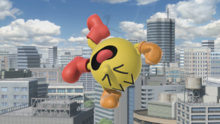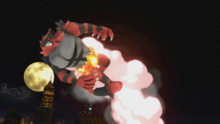Tumbling: Difference between revisions
KirbyMelee (talk | contribs) No edit summary |
(Added images from Ultimate.) |
||
| Line 1: | Line 1: | ||
{{ArticleIcons|series=y}} | {{ArticleIcons|series=y}} | ||
{{image|Screenshots for all games.}} | {{image|Screenshots for all games.}} | ||
[[File: | [[File:SSBU PacMan Tumble.png|220px|thumb|{{SSBU|Pac-Man}} tumbling in ''[[Ultimate]]''.]] | ||
'''Tumbling''' (or '''DamageFall''' internally in ''Melee'' and ''Brawl'' files) is an airborne state that a character may enter after being hit or pushed in certain ways; for example, [[edge slip]]ping can cause a character to tumble. A tumbling character can easily be identified by their defensive, rotating animation. Characters may tumble after being hit through the air by an attack with strong enough [[knockback]], [[footstool]]ed in midair, pushed off a ledge, after walking off an edge while carrying a [[crate]] or other heavy [[item]], or by sliding off of an [[edge]] while [[shield]]ing. | '''Tumbling''' (or '''DamageFall''' internally in ''Melee'' and ''Brawl'' files) is an airborne state that a character may enter after being hit or pushed in certain ways; for example, [[edge slip]]ping can cause a character to tumble. A tumbling character can easily be identified by their defensive, rotating animation. Characters may tumble after being hit through the air by an attack with strong enough [[knockback]], [[footstool]]ed in midair, pushed off a ledge, after walking off an edge while carrying a [[crate]] or other heavy [[item]], or by sliding off of an [[edge]] while [[shield]]ing. | ||
| Line 19: | Line 19: | ||
==Reeling== | ==Reeling== | ||
[[File: | [[File:SSBU Reeling Incineroar.png|220px|thumb|{{SSBU|Incineroar}} reeling in ''[[Ultimate]]''.]] | ||
'''Reeling''' (or '''DamageFlyRoll''') is a state similar to hitstun, except the characters enter a helix motion. In all games, this only occurs once the character is at 100% or more, and occurs 30% of the time. During this state, characters cannot do anything except [[DI]], or tech if they come into contact with a wall or ceiling. Once the knockback diminishes and the character slows down, reeling ends and tumbling begins. Teching is useful for characters with high damage, or during [[Sudden Death]] matches, since being attacked under such circumstances often causes reeling. Reeling can also occur after using the {{b|Bullet Bill|item}}; however, it does not end naturally, and can be canceled by using an [[aerial attack]] or [[air dodge]], or landing. | '''Reeling''' (or '''DamageFlyRoll''') is a state similar to hitstun, except the characters enter a helix motion. In all games, this only occurs once the character is at 100% or more, and occurs 30% of the time. During this state, characters cannot do anything except [[DI]], or tech if they come into contact with a wall or ceiling. Once the knockback diminishes and the character slows down, reeling ends and tumbling begins. Teching is useful for characters with high damage, or during [[Sudden Death]] matches, since being attacked under such circumstances often causes reeling. Reeling can also occur after using the {{b|Bullet Bill|item}}; however, it does not end naturally, and can be canceled by using an [[aerial attack]] or [[air dodge]], or landing. | ||
| Line 32: | Line 32: | ||
Marth tumble.jpg|{{SSBM|Marth}} tumbling in ''[[Brawl]]''. | Marth tumble.jpg|{{SSBM|Marth}} tumbling in ''[[Brawl]]''. | ||
Wolfflash.jpg|{{SSBB|Falco}} reeling as a result of a sweetspotted [[Wolf Flash]] in ''[[Brawl]]''. | Wolfflash.jpg|{{SSBB|Falco}} reeling as a result of a sweetspotted [[Wolf Flash]] in ''[[Brawl]]''. | ||
G&WtumbleSSB4.jpg|{{SSB4|Mr. Game & Watch}} tumbling in ''[[Smash for 3DS]]''. | |||
PalutenaReeling.jpg|{{SSB4|Palutena}} reeling in ''[[Smash for 3DS]]''. | |||
</gallery> | </gallery> | ||
Revision as of 22:20, January 4, 2019
Tumbling (or DamageFall internally in Melee and Brawl files) is an airborne state that a character may enter after being hit or pushed in certain ways; for example, edge slipping can cause a character to tumble. A tumbling character can easily be identified by their defensive, rotating animation. Characters may tumble after being hit through the air by an attack with strong enough knockback, footstooled in midair, pushed off a ledge, after walking off an edge while carrying a crate or other heavy item, or by sliding off of an edge while shielding.
In all Super Smash Bros. games, the minimum knockback that must be inflicted to cause tumbling is roughly 80 units.
Actions possible while tumbling
Tumbling is not the same state as helplessness; after hitstun ends, tumbling characters can carry out most normal airborne actions while tumbling:
- They can move horizontally through the air as per normal.
- They can perform aerial attacks, use any remaining jumps, and use any special moves, all of which end the tumbling state.
- In Super Smash Bros. Brawl and Super Smash Bros. 4, air dodging can also be performed as per normal and will end tumbling—this was not possible in Super Smash Bros. Melee. It is not possible to use a grab aerial while tumbling, though, as attempting to do so results in an air dodge (aerial attack in Smash 4).
- In Melee and Brawl, they can end the tumble and resume their normal aerial state by tapping horizontally on the Control Stick.
- They can tech if they are about to hit a platform. If the tumbling was caused by a footstool jump, however, there is a short period during which the character cannot tech.
- They can still grab ledges as usual. In Melee, they can tech on them if facing the opposite side, and canceling a tumbling state by grabbing a ledge awards the Life on the Edge bonus, which gives 800 points for each time this is achieved.
If tumbling characters hit the ground without teching, they will land into a lying position and must then use a floor recovery. Characters undergo a flopping animation upon hitting the ground before they can use their floor recovery, leaving them vulnerable for a short while.
The tumbling animation is used after a shield jump, though no action can be performed during this time. It is also used at the end of Olimar's Final Smash (after emerging from the Hocotate Ship), but Olimar will be unable to do anything other than move horizontally.
Reeling
Reeling (or DamageFlyRoll) is a state similar to hitstun, except the characters enter a helix motion. In all games, this only occurs once the character is at 100% or more, and occurs 30% of the time. During this state, characters cannot do anything except DI, or tech if they come into contact with a wall or ceiling. Once the knockback diminishes and the character slows down, reeling ends and tumbling begins. Teching is useful for characters with high damage, or during Sudden Death matches, since being attacked under such circumstances often causes reeling. Reeling can also occur after using the Bullet Bill; however, it does not end naturally, and can be canceled by using an aerial attack or air dodge, or landing.
Because of the character's two-dimensional nature, Mr. Game & Watch has a unique reeling animation. Instead of spinning, he repeatedly cartwheels as he is launched.
In Smash 4, the reeling animation does not allow characters to tech on the floor until the hitstun cancel window starts. However, it does allow Cloud to tech walls and ceilings if he is hit near the apex of Climhazzard, where teching is otherwise impossible.
The tornadoes in Hyrule Castle and PictoChat 2 will cause reeling no matter what damage percentage the character is at.
Gallery
Falco reeling as a result of a sweetspotted Wolf Flash in Brawl.
Mr. Game & Watch tumbling in Smash for 3DS.
Palutena reeling in Smash for 3DS.
Trivia
- The animation for tumbling is the same used in the character's Star KO animation, as well as the Screen KO in Smash 64 and Brawl.
- A unique tumbling animation is used for characters who are footstooled in midair. This same animation is also used for when characters enter doors in midair.
- Whenever Wolf is in tumbling animation, his left arm will detach from his elbow. This can be clearly seen when pausing the game.
- Characters' facial expressions when tumbling has changed over the series, in Smash 64 and Brawl, every character will have a wincing look on their face, while in Melee, Smash 4, and Ultimate characters will have a more surprised look besides Mr. Game and Watch.






